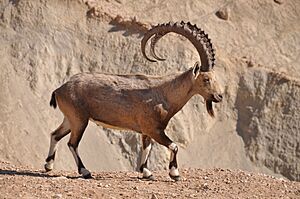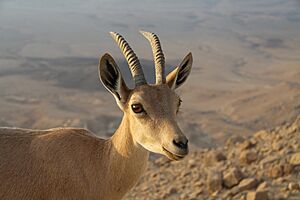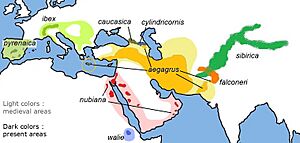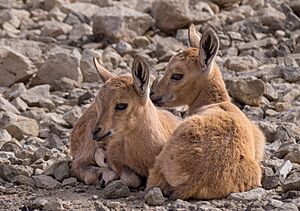Nubian ibex facts for kids
Quick facts for kids Nubian ibex |
|
|---|---|
 |
|
| Male | |
 |
|
| Female | |
| Conservation status | |
| Scientific classification |
The Nubian ibex (Capra nubiana) is a type of wild goat that lives in the desert. You can find them in the mountains of northern and northeast Africa, and the Middle East. People used to think they were a kind of Alpine ibex, but now we know they are their own special species. There are about 4,500 adult Nubian ibex in the wild. Because of this, they are listed as a vulnerable animal, meaning they need protection.
Contents
About the Nubian Ibex Family
Ancient History
Nubian ibex have lived in places like Israel for a very long time, about 150,000 years! Even when people started raising many goats and other farm animals, the Nubian ibex stayed around. Their numbers have changed over time. For example, in Ein Gedi, their population grew a lot between 949 and 5,164 years ago. Scientists have found old bones that show Nubian ibex were hunted by Arabian leopards for thousands of years.
Family Tree Connections
The Nubian ibex belongs to the Capra family, which includes all other ibex and goats. Scientists use DNA to figure out how these animals are related. It's a bit like building a family tree!
One study looked at Y-chromosome DNA and found two main groups. One group has domestic goats and markhors. The other group has all other ibex, including the Nubian ibex. In this study, the Nubian ibex seemed most closely related to the Siberian ibex.
But another study, using different DNA (Mitochondrial DNA), showed different results. This means the ibex family tree can be tricky to figure out! Some scientists think that the Nubian ibex might be most closely related to the Walia ibex from Ethiopia. They might have split apart about 800,000 years ago.
Scientists also found that the Nubian ibex population was quite large during warmer times in history. It then got smaller during the last ice age. Their genes haven't changed much in at least 2,000 years.
Here is a simple family tree for some Capra species:
| Capra |
|
||||||||||||||||||||||||||||||||||||
What Nubian Ibex Look Like
Nubian ibex are the smallest type of ibex. They stand about 65 to 75 centimeters (about 25-30 inches) tall at the shoulder. Males and females look different. Males are much bigger than females. Males usually weigh between 52 and 74.7 kilograms (about 115-165 pounds). Females weigh between 25.3 and 32.7 kilograms (about 56-72 pounds).
| Sex & Age | Number of individuals (n) | Average weight (kg) |
|---|---|---|
| Female (~4 years) | 22 | 32.7 |
| Male (2–3 years) | 5 | 37.8 |
| Male (4 years) | 3 | 53.7 |
| Male (~7 years) | 8 | 74.7 |
They are light tan with a white belly. Males have a dark brown mane (long hair) down their backs. Their legs have a black and white pattern. They also have a lighter rump with a dark brown tail. Males start growing a beard when they are 2 or 3 years old. This beard gets longer and darker as they get older. During the autumn breeding season, older males grow very dark brown fur on their chest and sides.
Nubian ibex have long, thin horns that curve up and then back. Male horns can grow to about 1 meter (3 feet) long! Female horns are much smaller, around 30 centimeters (1 foot). Male horns are thicker and have large bumps. These bumps help their horns from sliding when they fight other males. Horn growth slows down for males around age 7-8 and for females around age 4-6. The number of ridges on their horns tells you how old they are.
Where Nubian Ibex Live
Long ago, Nubian ibex lived all over the Middle East and Northeast Africa. Today, you can find them in Egypt, Jordan, Oman, Israel, Palestine, Saudi Arabia, and Sudan. They used to live in Lebanon and Syria but are now gone from those places. However, Lebanon is trying to bring them back. We are not sure if they are still in Ethiopia, Eritrea, and Yemen.
How Nubian Ibex Live
What They Eat
Nubian ibex live in dry, rocky mountains. They mostly eat grasses and leaves, especially from Acacia trees. They can eat food from the ground or stand on their back legs to reach leaves higher up. They can even climb into trees to eat! They try to avoid plants that have strong defenses, like thorns. What they prefer to eat changes with the rain. After a rainy winter, they like to eat more annual plants (plants that live for one season).
Ibex like to eat near cliffs. Cliffs offer a safe place to escape from predators. The farther they are from cliffs, the more careful they become. They also spend more time eating in green areas with good food that are close to water. Female ibex in Oman have even been seen eating small bone pieces. This helps them get enough calcium and phosphorus.
Friends and Foes in Nature
Nubian ibex are hunted by animals like Arabian leopards, Arabian wolves, golden jackals, caracals, red foxes, golden eagles, Eurasian eagle owls, and bearded vultures. When they sense danger, they make a loud, high-pitched call to warn other ibex.
They share their home with other plant-eating animals. These include rock hyrax, Arabian oryx, gazelles, and Asiatic wild ass. Nubian ibex have a helpful relationship with Tristram's starling, a small bird that eats parasites off the ibex's skin.
They can also have parasites like flies, lice, ticks, and mites.
Social Life
Ibex are social animals. Herds usually have females, young ibex, and males up to about three years old. A herd usually has up to 20 ibex, but sometimes as many as 50. Female herds often consist of related ibex and have a pecking order. Males usually live alone or in small groups of up to eight. During the breeding season, males join the female herds for about six to eight weeks. Big males will fight each other, clashing their horns loudly.
Daily Movements
Nubian ibex are diurnal, meaning they are active during the day and rest at night. Like other ibex, they spend a lot of time on and around cliffs. Cliffs keep them safe from predators. They feel more danger the farther they are from cliffs. They can climb and jump very well, covering several meters in one leap. Ibex often walk in a single line on cliffs, staying mostly level. Their repeated movements create clear trails on hillsides.
Ibex move around throughout the day and year. During the day, they move between food spots. They might rest during the day to chew their cud, especially around midday. On cold winter days, ibex in Egypt have been seen following the sun's path to stay warm. At night, they sleep in small holes they dig on cliff sides. These small holes create tiny microclimates where different plant seeds can grow, making the habitat more diverse. In winter and early spring, when it rains, ibex often spread out to open areas to eat new plants. In the hot, dry summer, they gather around shady oases where there is water and green plants.
Reproduction and Life Cycle
Mating season for Nubian ibex is usually in October and November. During this time, a strong male will try to mate with several females. Males produce a strong smell when females are ready to mate. They will smell the female's rear end with their lip curled up (this is called Flehmen). Males can start breeding as young as 2 years old. However, they might not get to mate until they are about 5 years old, when they are strong enough to fight other males. Females can breed as young as six months old, but usually start between 1 and 3 years old. Some groups of Nubian ibex are starting to have a second mating season in the spring. This might be because of very dry climates.
Pregnancy lasts for 5 months. Usually, 1 or 2 babies (called kids) are born between March and July. Most births happen in a 3-4 week period in late March and April. Females leave the herd to give birth in a quiet, hidden spot. Newborns can stand up within 15 minutes of being born and can drink milk within two hours. The mother and young join the herd again in a few days. They often join other mothers and young to form a special group called a crèche for several weeks. Leaving kids in a crèche allows mothers to find better food and go to places farther from cliffs. Kids stop drinking milk around 4 months old. Females reach their full size at age 3-4, while males reach it around 6 years old. Nubian ibex can live up to 12 years in the wild and 18 years in zoos.
How Humans Affect Nubian Ibex
Threats to Ibex
The International Union for Conservation of Nature (IUCN) says the Nubian ibex is "vulnerable". This means there are fewer than 10,000 adult ibex left, and their numbers are going down.
Here are some things that threaten them:
- Competition: They have to compete with farm animals for water and food.
- Hunting: People hunt them.
- Habitat Loss: Their homes are being broken up or destroyed.
When people visit nature reserves for tourism or outdoor fun, it can bother the ibex. They might change their behavior to avoid people. They will look for water sources where there are fewer people. They might even leave good food spots if there are too many humans around. When tourists stopped visiting Israel's Ein Avdat Nature Reserve during the COVID-19 lockdowns in 2020, the number of young ibex compared to females more than doubled!
On the other hand, some ibex have gotten used to living near towns and popular nature spots. This can cause problems. These ibex might not be as careful around predators. They go to towns because there's lots of food and shelter. But this can lead to them damaging property or eating harmful things like trash.
Conservation Efforts by Country
Here's how many wild Nubian ibex are estimated to be in different countries:
| Country | Population | Details |
|---|---|---|
| Egypt | 600–1,250 | There are two main groups. One is in the Eastern Desert (400–1,000 ibex). The other is in the South Sinai (200–250 ibex). Their numbers are going down because of poaching (illegal hunting). Egypt protects them by law. |
| Eritrea | Unknown | We don't know the exact number due to conflicts. A wildlife reserve was set up in 1959 to protect them. |
| Ethiopia | Unknown | We don't know the exact number due to conflicts. |
| Israel and Palestine | 1,200–1,500 | Their population was very low after World War I. But after Israel made hunting illegal and created nature reserves, their numbers grew back. They live in the Negev Highlands, Eilat Mountains, and Judaean Desert. These areas are connected, which helps the ibex move around. A small group was also brought back to the Golan Heights in 1970. Israel's population is stable and well-protected. The Nature and Parks Authority counts them every year. Israel protects them by law. |
| Jordan | 480–600 | Jordan has brought back their ibex population through special breeding programs. Strong groups live in protected areas like Dana Biosphere Reserve (250 ibex), Wadi Mujib Biosphere Reserve (200 ibex), and Wadi Rum World Heritage Area (100 ibex). Their main threat is hunting. Jordan protects them by law. |
| Lebanon | 19; bringing them back | Nubian ibex disappeared from Lebanon in the mid-1800s. In 2017, a small group was brought from Jordan to a reserve. They live in a fenced area now, with plans to release them fully into the wild soon. |
| Oman | 700–1,350 | Most live in the Dhofar Mountains (600–1,100 ibex). Another group lives near Al Wusta Wildlife Reserve (100–250 ibex). Their numbers are going down because of poaching, habitat damage, and human growth. Oman protects them by law. |
| Saudi Arabia | Present, no official number | Small groups live in protected areas. The population in the Ibex Reserve has dropped by 75% since 2005 due to poaching. In 2022, Saudi Arabia started a program to bring them back. Saudi Arabia protects them by law. |
| Sudan | Potentially a few hundred; no official number | Before 2010, there were small groups in the Red Sea Hills. But due to conflicts, we don't have recent numbers. Sudan allows limited hunting with a permit. |
| Yemen | Likely present, no official number | Ibex have been seen in the Hawf Protected Area. Due to conflicts, we don't have recent numbers. |
Ibex in Zoos
Nubian ibex live in zoos around the world.
| Continent | Details |
|---|---|
| Africa | You can find Nubian ibex in Egypt's Giza Zoo. |
| Asia | They live in 16 zoos in Israel, including a breeding group in the Jerusalem Biblical Zoo. They are also in zoos in the United Arab Emirates, Gaza, and Singapore. Oman has a breeding center at Al Baraka Palace. |
| Europe | Nubian ibex live in one zoo in each of these countries: Estonia, France, Germany, Poland, and Switzerland. |
| North America | As of 2013, there were at least 34 males and 39 females in 8 zoos. Most of these zoos are approved by the Association of Zoos and Aquariums (AZA). All these ibex came from Israel's Yotvata Hai-Bar Nature Reserve. Some people keep them on private ranches for hunting. |
Nubian Ibex in Culture
Ancient Times
Nubian ibex have been a popular image in art for thousands of years in the Middle East. You can see them in rock carvings, metalwork, and pottery. Some art is as old as the Stone Age. In rock carvings, ibex are often shown being hunted by dogs and people with bows. They are also often shown with stars, suns, or circles. People used to hunt them using long walls that led to an enclosure, dogs, and nets.
The ibex in art might show real hunts. But they could also represent spiritual ideas like resurrection (coming back to life), seasonal cycles of rain and dry times, and the balance of life and death. Ibex might have been symbols for ancient gods like Dumuzi or Almaqah. They are often linked to the Capricorn constellation in ancient art.
A common image in old Middle Eastern art shows a sacred tree, often called the Tree of Life. On each side of the tree, there is an ibex. This image is found all over the region.
In Jewish Culture
The name of the Biblical hero Yael means "Ibex" in Hebrew. The Tanakh (Jewish Bible) mentions ibex several times: "The high mountains belong to the ibex" (Psalm 104:18). The spring of Ein Gedi, near the Dead Sea, means "Spring of the goat-kid." This place is in the story of King David.
The horn of an ibex can be used to make a Shofar (a Jewish religious horn). Ibex are also a Kosher animal, meaning they can be eaten if prepared correctly according to religious law.
Ibex skin was sometimes used to make scrolls in ancient Israel. You can see ibex in old Jewish art, like a mosaic from the 5th Century in the Huqoq Synagogue.
Today, Yael (יָעֵל) is a common name for Jews, and it's very popular for baby girls in Israel. The Nubian ibex is the symbol of the Israel Nature and Parks Authority (INPA). It was chosen because it represents Israeli wildlife and because its curved horn looks like an old Roman arch, showing local history.
In Bedouin Culture
Bedouin people used to raise young Nubian ibex with their domestic goats. The ibex and goats could even have babies together. Some Bedouin groups have named places after ibex. In Israel, a Bedouin tribal symbol was made by changing older ibex rock art. Bedouin traditionally hunted ibex for food and skin. More recently, some Bedouin in the Sinai region have helped protect ibex and other wildlife.
In Yemen
In Yemen, the ibex is a long-standing symbol of their country. It represents many good qualities of the Yemeni people. People have suggested an annual National Ibex Day on January 22 to help protect the animal.
In Modern Media
The Nubian ibex was shown in the BBC documentary Life. It was also a big part of the popular TV show Planet Earth (in the "Deserts" episode).
Ecotourism
Pictures of Nubian ibex are often used to promote ecotourism. The Israeli town of Mitzpe Ramon, where ibex are often seen, has a hotel called the Ibex Inn. In Jordan, Wadi Rum has a tour company called Wadi Rum Ibex. Many tour companies in the Middle East encourage people to come and see these animals in the wild.
See also
- List of mammals of Israel
- List of animals in the Bible
- List of mammals of Jordan
- List of mammals of Egypt





